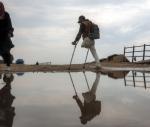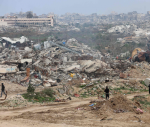You are here
Jordan’s energy match: solar 1 nuclear 0
Dec 10,2016 - Last updated at Dec 10,2016
In 2007, under His Majesty King Abdullah’s “directives and personal interest”, the Jordan Atomic Energy Commission (JAEC) was established, and the country started moving towards the acquisition of its first nuclear plant.
The White Paper on Nuclear Energy in Jordan put out by JAEC “estimated that… the first Jordanian nuclear power plant will be commissioned in 2020”. It has become clear that this target will not be met.
In the meantime, solar energy has already made an entry. With investments of about $160 million, which is likely less than what Jordan has spent on its nuclear programme so far, the recently completed Shams Maan project demonstrates the potential of solar energy in Jordan.
The key problem for Jordan’s nuclear plans is finance. JAEC plans to import two large reactors from Russia at a cost of $10 billion; Russia is to finance 49.9 per cent of the nuclear power plant.
But there is still the remaining 50.1 per cent, and JAEC is finding it practically impossible to come up with that amount.
In October 2015, JAEC Chairman Khaled Toukan told the press that the commission is “now in trilateral discussions and seeking strategic partners — technology providers as well as finance partners”.
But this has clearly not borne fruit so far. As a result, JAEC has started talking about importing small modular reactors, designs that are yet to be constructed, from the United States.
It is unclear if or when the nuclear financing dilemma will be resolved. In the meanwhile, without any fuss, private investors have financed the first utility scale solar photovoltaic project in Jordan.
With a current installed capacity of 52.5 megawatts, about 1.5 per cent of Jordan’s total installed power generating capacity, the Shams Maan project costs around $3,000 per kilowatt, roughly half the costs of nuclear new build in many countries.
Indeed, this value will likely decrease even further as solar capacity ramps up. And solar capacity is ramping up globally, much faster than nuclear power, and receiving much more investment.
As the 2016 World Nuclear Industry Status Report points out, “global investment decisions on new nuclear power plants remained an order of magnitude below investments in renewables”.
One might ask why investors prefer to finance solar energy projects rather than nuclear ones? There are two parts to the answer.
First, project costs for solar power plants are not just lower at a per unit capacity basis, these projects can be built at a variety of scales, suiting different investors and their financing abilities.
Second, there are a variety of risks associated with nuclear power projects, including the potential for cost and time overruns, severe accidents, political challenges (think of Iran!), and widespread negative public perception.
In terms of creating job opportunities as well, solar energy has won over nuclear power. Although JAEC has made some progress with developing a human resources base with its training and scholarships programmes, this pales in comparison with the number of jobs that the solar industry has created and can create in the future.
Academic studies in the United States estimate that solar photovoltaic power creates more than six times as many jobs as nuclear power for each unit of electricity generated.
And since solar electricity will very soon be, if it is not already, cheaper than nuclear power, there will be more jobs created for each dollar invested in solar photovoltaics than nuclear power.
Nuclear power faces other serious challenges in Jordan. Growing public disapproval, particularly in the region chosen to locate the reactors, and emerging security threats in neighbouring countries that could expand into Jordan make the nuclear project a real headache for the government.
That’s not to mention the technical challenges of incorporating large generation capacity into Jordan’s small, and relatively outdated, electricity grid.
The recent success of Shams Maan project and the potential of solar energy to expand quickly to meet Jordan’s rising energy needs, while attracting investments and creating job opportunities for young Jordanians, suggests that there is no good rationale to continue with the nuclear programme, which has seen investment but no returns so far.
The expected delays in constructing a nuclear reactor will not only defer the availability of electricity, but continue to drain money from Jordan’s strained budget and is a significant opportunity cost that would hinder investments in solar energy and grid upgrades.
Ali Ahmad is director of the Energy Policy and Security in the Middle East Programme at the Issam Fares Institute at the American University of Beirut. M. V. Ramana is with Princeton University’s Programme on Science and Global Security and the Nuclear Futures Laboratory and author of ‘The Power of Promise: Examining Nuclear Energy in India’ (Penguin Books, 2012). They contributed this article to The Jordan Times












